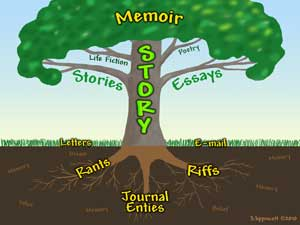

By Sharon Lippincott
How could I have known when I wrote my first lifestory that it was the beginning of a love affair with all forms of lifewriting? Through the ensuing years my passion for this form of writing has grown as I’ve moved beyond simple story to discover the joys of journaling, the ecstasy of essay, and the magic of memoir.
Through the dozen years that I’ve been teaching The Heart and Craft of Lifestory Writing, I’ve discovered that as the above graphic shows, life writing is an organic process with many modes. Each mode has powerful potential for healing and enhancing both physical and emotional health, and using them all together can be positively transformational.
Journal writing is perhaps the most widespread modality, simple to do, eminently affordable, requiring no special equipment or skills. Together with spontaneous freewriting I refer to as rants and riffs, it forms a supportive “raw writing” mode, drawing directly from the soil of memory, beliefs and values, hopes and dreams. Raw writing serves to make thinking visible, where it can be explored, examined, and transformed into insight and wisdom.
Simple stories and essays refine memories into narrative that deepens their meaning and significance. This writing is often shared with others, informally or through publication. Perhaps the most profound personal insight and transformation occurs among those who consolidate stories and essays into autobiography that records and documents events of their entire life, or memoirs that intensely explore specific time periods or themes.
While each of these aspects of life writing may stand on its own, they are also mutually supportive. The journal writer may review private writing and realize she wants to polish some of those ramblings into a carefully crafted story or essay to share with family and friends perhaps even the general public. The effort of editing generally sheds further light on the subject matter. Story and essay writers may turn to raw writing, whether in a journal or simple freewriting, to clear writers’ block or further develop an idea. Memoir and autobiography is comprised of a carefully crafted accumulation of scenes and narrative, much of which could stand on its own as stories or essays.
None of these forms is inherently better or more valuable than the other. Some people are content to stick with their journals. Others are happy to write a story or two, or perhaps pen an essay now and then, often in the form of a letter. Relatively few aspire to the lofty art of memoir, because it requires intense dedication, but those who do find it immensely rewarding.
All life writing, whether journaling or the more refined forms, dark or light, can enhance your health, and sharing it spreads those benefits. So be strong in your journaling, and brave and adventurous in polishing bits of its wisdom and wit to share with the world.
Bio:
Sharon Lippincott is the author of The Heart and Craft of Lifestory Writing. She teaches classes on lifestory writing and Writing for the Health of It in the Pittsburgh area and online, and coaches individual writers to help them refine their skills. She co-hosts the LifeWriters Forum on YahooGroups and sits on the advisory board of the National Association of Memoir Writers. Her blog has nearly 500 posts covering all aspects of life writing, and you’ll find helpful free downloads on her website.

Leave Comment